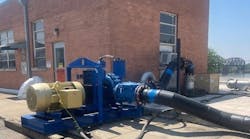A manufactured gas storage tank had contained gas, water and coal tar. Three million gallons of wastewater were stored in this tank. The critical contaminants where: PNAs, BTEXs, Oil and heavy metals. The goal of the remediation contract was to remove these contaminants from the wastewater to meet local discharge standards, in the most economical manner, and facilitate the removal of the tar trapped beneath the water.
The gas and water that needed to be removed were contained in two huge steel tanks. Mechanically emulsified tar oil in the form of benzene and xylene floated on top of the 1.5 ft (4.6 meter) coal tar bed, along with other contaminants. Once the water was removed, the tar could also be taken out. The discharge limits where: 74 ppb for benzene, and 134 ppb for xylene.
The first proposal involved the hauling away of the wastewater to a treatment plant that accepts hazardous wastewater. Cost: $1.3 million. Then a treatment system was installed that included: An oil/water separator, followed by a bag filter and two activated carbon vessels, each containing 6000 lb of virgin activated carbon. This set up lasted about 1 week until the carbon had to be replaced, because the tar oil quickly blinded it.
The contractor decided to precede the carbon vessels with two carbon tanks filled with organoclay from Biomin, Inc., Ferndale, MI., to protect the activated carbon from blinding by the oils. The wastewater analysis before and after treatment is shown below:
Chemical Influent Conc. Micrograms/lit Effluent Conc. Micrograms/l.
Benzene 19,430 or less 9.88
Toluene 8,835 or less 3.93
Ethyl Benzene 1,560 or less N/D
Total Xylene 7,130 or less 9.23
The concentration of benzene and xylene in this wastewater easily complied with the discharge standards. The process of hauling the wastewater to a treatment plant would have caused the owner of the storage tanks $1.3 million. The Organoclay/carbon system lasted six weeks, until the job was finished, and cost $350,000.-. Savings for the owner of the storage tanks: nearly $1 million.

